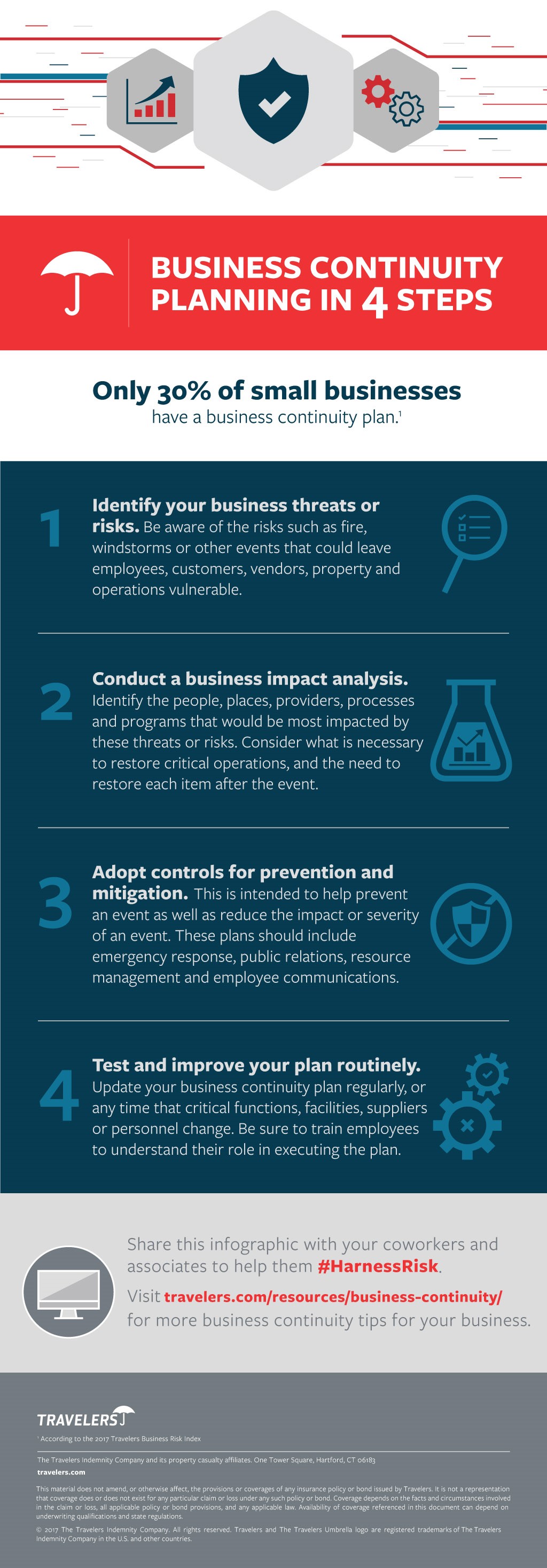Business Continuity Planning in 4 Steps


There are many reasons your company needs a business continuity plan. Having a strategy – before an event happens – helps to maximize the chance your business can recover while minimizing the loss of property, life and assets.
Developing your business continuity plan should be a thoughtful process resulting in a plan that can be beneficial to you if an event occurs.
Start by assembling a team of key decision-makers who will lead your continuity planning efforts. Senior management, team leaders and anyone with in-depth knowledge about business operations should be included.
Four steps to developing an effective business continuity plan
- Identify threats or risks
Understanding the risks that could leave employees, customers, vendors, property and operations vulnerable is fundamental. Threats can include, but are not limited to, natural disasters, malicious attacks, power outages and system failures.
Identify the risks most likely to occur based on historical, geographical, organizational and other factors. Then weigh the probability of each event against its potential impact to your business, as well as your readiness to respond. - Conduct a business impact analysis
Identify the people, places, providers, processes and programs critical to the survival of your business. What functions and resources, if interrupted or lost, could impact your ability to provide goods and services or meet regulatory requirements?
Consider who and what is absolutely necessary to restore critical operations. Then prioritize the need to restore each item after the event. Plan to use limited resources wisely. Complementary functions can always be restored later. - Adopt controls for prevention and mitigation
Prevention and mitigation planning and activities are intended to help prevent an event (such as a fire or explosion from unsafe conditions) as well as to reduce the impact or severity of an event (such as relocating critical equipment to a higher elevation in flood-susceptible areas).
Your prevention and mitigation plans should address, among other things, emergency response, public relations, resource management and employee communications. - Test, exercise and improve your plan routinely
A business continuity plan is an evolving strategy that should adapt to your company’s ever-changing needs. Test and update it regularly – yearly at a minimum – or any time critical functions, facilities, suppliers or personnel change. Train employees to understand their role in executing the plan, too.
Exercises can include discussions or hypothetical walk-throughs of scenarios to live drills or simulations. The key is to ensure the plan works as intended.

BUSINESS CONTINUITY PLANNING IN 4 STEPS
Only 30% of small businesses have a business continuity plan.1
- Identify your business threats or risks. Be aware of the risks such as fire, windstorms or other events that could leave employees, customers, vendors, property and operations vulnerable.
- Conduct a business impact analysis. Identify the people, places, providers, processes and programs that would be most impacted by these threats or risks. Consider what is necessary to restore critical operations, and the need to restore each item after the event.
- Adopt controls for prevention and mitigation. This is intended to help prevent an event as well as reduce the impact or severity of an event. These plans should include emergency response, public relations, resource management and employee communications.
- Test and improve your plan routinely. Update your business continuity plan regularly, or any time that critical functions, facilities, suppliers or personnel change. Be sure to train employees to understand their role in executing the plan.
Share this infographic with your coworkers and associates to help them #HarnessRisk.
Visit travelers.com/resources/business-continuity/ for more business continuity tips for your business.
1According to the 2017 Travelers Business Risk Index
The Travelers Indemnity Company and its property casualty affiliates. One Tower Square, Hartford, CT 06183
travelers.com
This material does not amend, or otherwise affect, the provisions or coverages of any insurance policy or bond issued by Travelers. It is not a representation that coverage does or does not exist for any particular claim or loss under any such policy or bond. Coverage depends on the facts and circumstances involved in the claim or loss, all applicable policy or bond provisions, and any applicable law. Availability of coverage referenced in this document can depend on underwriting qualifications and state regulations.
© 2017 The Travelers Indemnity Company. All rights reserved. Travelers and The Travelers Umbrella logo are registered trademarks of The Travelers Indemnity Company in the U.S. and other countries.



